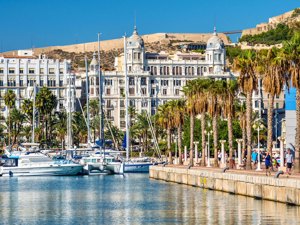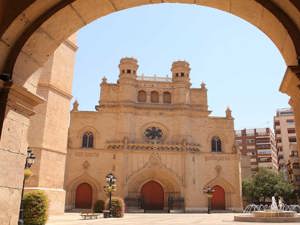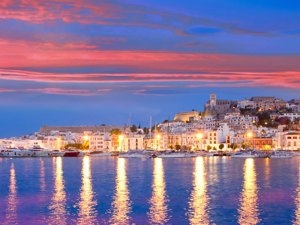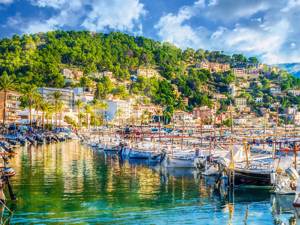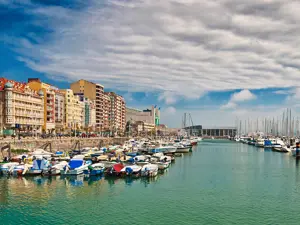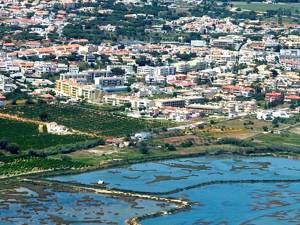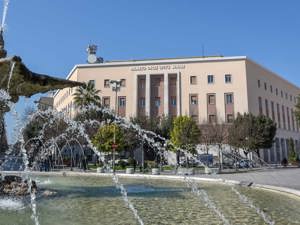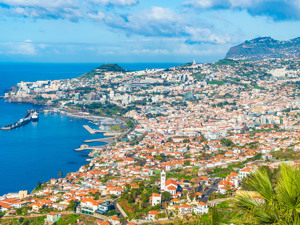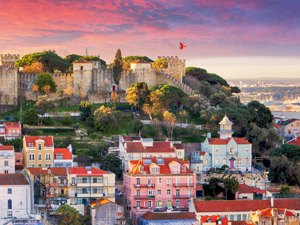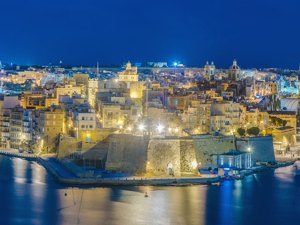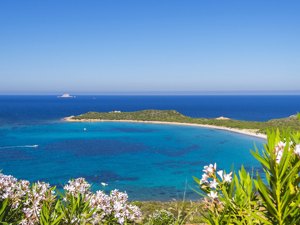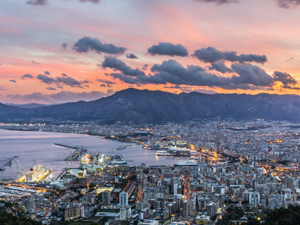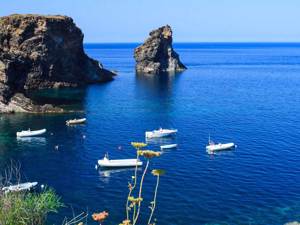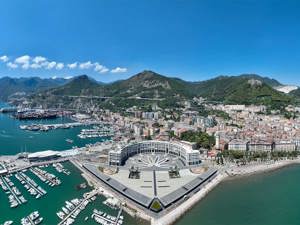The island of art and fire
Magical volcanic landscapes, beaches, crystal-clear waters and protected nature reserves, a treasure trove for those who love to experience nature at its best. In Lanzarote many have wanted to find the remains of the legendary Atlantis, the great civilisation that dared to challenge the gods, which disappeared into the depths of the ocean. In fact, on this particular island of the Canaries, traces of powerful natural events that left their mark on the land are extremely evident and make one imagine ancestral battles. It’s no coincidence that Lanzarote has been named the ”island of volcanos”.

Lanzarote. National Park of Timanfaya. Copyright © Sisterscom.com / Shutterstock
Volcanos have left their mark on this island more than any other in the archipelago, giving it lunar landscapes tinted with ochre, violet and black. Lanzarote, in just 800 square kilometres the island has over 100 volcanic craters and is traversed by rivers of petrified lava that appear like shiny strips of liquorice. A large part of the land is distinguished by the historic eruptions of Timanfaya, which took place between 1730 and 1736.

Lanzarote. Charco de los Clicos. Copyright © Sisterscom.com / Shutterstock
The volcanos have created beautiful, majestic natural structures, which inspired César Manrique, an artist of international fame who came from Lanzarote, to plan the development of Centres of Art, Culture and Tourism of Cabildo in Lanzarote. Here the artist combined art and nature by applying a philosophy and model for action based on sustainability. To learn more about his works and the natural wonders of the island there are two main itineraries to follow.
The north itinerary in Lanzarote
The north itinerary features steep, craggy elevations. The landscape is defined by two great massifs: the Risco de Famara, which extends for 22 km and, on the other side, the volcano Monte de la Corona, whose eruptions produced a vast volcanic area of great interest and beauty known as "malpaís" (badlands), which extends from the foothills to the coast.

Lanzarote. Coast Risco de Famara. Copyright © Sisterscom.com / Shutterstock
Arcipelago Chinijo
To the north of the island lies a sub-arcipelago known as Arcipelago Chinijo, which is made up of a group of small islands: La Graciosa, Alegranza, Montaña Clara, Roque del Este and Roque del Oeste or el Infierno. These islands, together with Risco de Famara, combine to form an area of exceptional scenic and natural value.

Lanzarote. Island Graciosa. Copyright © Sisterscom.com / Shutterstock
This area is the site of the cultural centres of Mirador del Río in the upper part of Risco de Famara; Cueva de los Verdes and Jameos del Agua in Malpaís de la Corona, and the last work of César Manrique, probably the most metaphorical, the Cactus Garden in the area of Guatiza.

Lanzarote. The cactus garden. Copyright © Sisterscom.com / Shutterstock
The south itinerary in Lanzarote
The south itinerary has more gentle elevations compared to those in the north. The south of the island has very different countryside, with semi-arid land in the area of Jable, the mountains of Macizo de los Ajaches and the celebrated and surprising volcanic landscape of Timanfaya, which occupies almost a third of the island.

Lanzarote. Montañas del Fuego. Copyright © Sisterscom.com / Shutterstock
The following centres are found along the south itinerary: Casa-Museo Monumento al Campesino (House-Museum-Monument to the Peasant) in the centre of the island; Montañas del Fuego (Mountain of Fire) in the heart of Timanfaya and finally, in the island’s capital, the International Museum of Contemporary Art - San José Castle.

Lanzarote. Puerto del Carmen. Copyright © Sisterscom.com / Eddy Galeotti / Shutterstock
We can also include the prestigious César Manrique Foundation, situated in "Taro de Tahíche", the old home of the artist built on petrified lava. If the inland areas of Lanzarote offer exciting landscapes, we cannot possibly forget the island’s coastlines and splendid beaches of golden or black sand, bathed by transparent waters.

Lanzarote. Playa Blanca. Copyright © Sisterscom.com / Shutterstock
Thanks to the mild climate, swimming and many other sports are possible all year round. The ideal holiday would be to combine a visit to the cultural centres with a tour of the coastal locations to discover villages with a seafaring flavour, far from the crowds of tourists, such as Arrieta, Punta mujeres or Órzola. The most popular beaches on the island are located in the south, including Puerto del Carmen and Playa Blanca, which are surrounded by most of the island’s largest tourist resorts offering fun and relaxation.
Text by Lea Tocchi
Updated by Alisè Vitri
Avion Tourism Magazine
Photos: Sisterscom.com, Shutterstock.
Photos: Sisterscom.com, Shutterstock.
Copyright © Sisterscom.com All rights reserved.
Video: www.turismolanzarote.com
Video: www.turismolanzarote.com
Tourism Board
www.turismolanzarote.com
www.spain.info
www.spain.info
Partnership with Booking.com
Where to sleep in Lanzarote

Lanzarote. Charco de San Gines lagoon. Copyright © Sisterscom.com / Shutterstock
Lanzarote is a welcoming city and offers different possibilities for accommodation.
To find the ideal hotel and the best offers you can do a search for the stars but also for districts or landmarks.
STARS
Hotels in the islands for stars, differentiated by type of services:
WHERE TO GO IN LANZAROTE
Nature and Museums in Lanzarote

Copyright © Sisterscom.com / Shutterstock
EL MIRADOR DEL RÍO
El Mirador del Río is located high up on the Risco de Famara, it is one of the architectonic creations most characteristic of César Manrique. This building is barely noticeable from the outside because the structure is hidden beneath a heavy layer of rock which mimics the surrounding landscape. There, we can see one of Lanzarote's most spectacular panoramas.

Copyright © Sisterscom.com / Shutterstock
LA CUEVA DE LOS VERDES
The tunnel formed by La Corona Volcano is one of the longest and most interesting on the planet. Over six kilometres of the tunnel have been explored, and they extend from the crater of the volcano before entering the sea in an underwater stretch of one-and-a-half kilometres, known as the Tunnel of Atlantis.

Copyright © Sisterscom.com / Shutterstock
JAMEOS DEL AGUA
Los Jameos del Agua, like La Cueva de los Verdes, are located inside the volcanic tunnel created by the eruption of La Corona Volcano. Los Jameos del Agua (a jameo is a volcanic cave with a collapsed roof) owe their name to the existence of an internal lake.

Copyright © Sisterscom.com / Shutterstock
INTERNATIONAL MUSEUM OF MODERN ART (MIAC)
The Museo Internacional de Arte Contemporáneo (MIAC) is situated in the old military fortress of the Castillo de San José. The museum was founded in 1975 with the aim of "promoting, bringing together and exhibiting the most important works of modern artistic creation".

Copyright © Sisterscom.com / Shutterstock
MUSEUM-HOUSE AND MONUMENT TO FERTILITY
In the centre of Lanzarote stands one of the works of César Manrique that carries that most symbolic references: the architectonic collection of the Casa-Museo del Campesino and Monumento a la Fecundidad.
It is made up of a series of buildings which are inspired by typically traditional architecture of Lanzarote, it reproduces the local rural houses.
It is made up of a series of buildings which are inspired by typically traditional architecture of Lanzarote, it reproduces the local rural houses.
Excursions in Lanzarote

Copyright © Sisterscom.com / Shutterstock
THE FIRE MOUNTAINS
The Montañas del Fuego or Timanfaya form part of a wide area affected by the volcanic eruptions that struck Lanzarote between 1730-1736. The fascinating volcanic landscape produced by such volcanic activity includes some geysers coming from the subsoil, actually from a residual chamber of magma close to the surface.

Copyright © Sisterscom.com / Shutterstock
THE CACTUS GARDEN
The Jardín de Cactus is a magnificent example of an architectonic intervention integrated into the landscape. In the Centre's five thousand square metres, there are over seven thousand two hundred examples of over one thousand one hundred different species, originating from very different places of the world.
Partnership with GetYourGuide
Tours and excursions in Lanzarote
You might be interested in
Other destinations
Airports nearby Lanzarote


